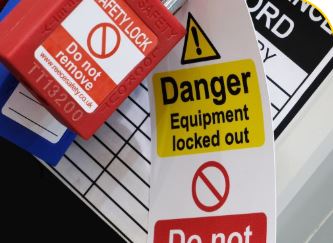
When conducting maintenance, cleaning, or repairs on any machinery or equipment in the workplace it’s important to ensure that accidental re-energisation does not occur, which can result in injury or even fatalities. In order to ensure that you are safety compliant, and have a secure working environment for your employees and contractors, it is vital that you have procedures in place.
A commonly used method for safely isolating equipment is lock out tag out. This process locks the energy source on the machinery in the first instance, this lock is then tagged with a clearly identifying label. The machinery is then tested to ensure that it has been safely shut down and stored energy safely isolated.
Lock Out Tag Out
Lock out tag out safely controls hazardous energy and has clearly defined steps, which when performed correctly will ensure machinery and equipment are safe to perform maintenance, repair or cleaning work on. Here are the stages of lock out tag out:
Prepare
Before you begin any shut down procedures it is important to identify all primary and secondary energy sources, as well as any potential hazards. Any personnel in the area should be made aware that a lock out procedure will be taking place and to not attempt to restart the equipment. Assessing potential hazards prior to beginning work, and ensuring a plan is in place for controlling these, will reduce the likelihood of accidents occurring.
Shut Down
Begin your shut down by following the correct procedures for your equipment. It is important to adhere to your correct shut down process in order to ensure everything is correctly switched off and your workers remain safe.
Equipment Isolation
In your preparation stage you should have identified and labelled all of your energy sources and isolation points on your equipment. During this phase you should ensure that all primary and secondary sources and power supplies have been isolated correctly with the appropriate isolation device.
Lock Out
Your isolation devices should now be locked with an appropriate fitting lock and tagged in compliance with your safety procedures. Lock out devices such as padlocks and tags should be stored safely in a lock out station and not be used for any other procedures in the workplace.
Once your lock is safely and securely applied, tag this lock with details of the person who applied it, and the time and date as required. The tag should be securely in place as this will act as an identifier for the person who applied the lock, and ensures that no one else attempts to remove it.
Energy Isolation
All moving parts on your equipment should have ceased moving with the shut down and equipment isolation phases but it is important to carefully inspect for any other potential hazards, such as spring driven parts, or any parts which could fall. Use appropriate blocking equipment to safely stop these hazards from occurring.
Drops in pressure can cause hydraulic or pneumatic systems to move even after the equipment has been shut down due to residual stored energy, so this stage should be carefully completed to prevent accidents occurring.
Verify Isolation
Once your area is clear of other personnel and your lock out devices have been applied correctly, you should verify your isolation. Do this by attempting to restart the equipment, this should not restart if every stage has been completed correctly. Once your ‘try out’ phase is complete ensure that all controls are switched off once more.
Conduct Required Work
At this point it is now safe to conduct any required work on your equipment. This should be in line with any other safety procedures in your workplace. It is worthwhile at this point once again to ensure that any other workers in the area are aware a lock out procedure taking place.
Reactivate
After your required work is completed, lock out devices, tags and any blocks can be removed, and the equipment safely restarted in accordance with your company procedures.
The lock out tag out method helps to ensure the safety of workers and prevent accidents from occurring. Anyone who works on machinery and equipment should be trained to a high standard to understand lock out tag out, and this should also be required of any contractors hired to perform repairs, maintenance, or cleaning on your equipment.
